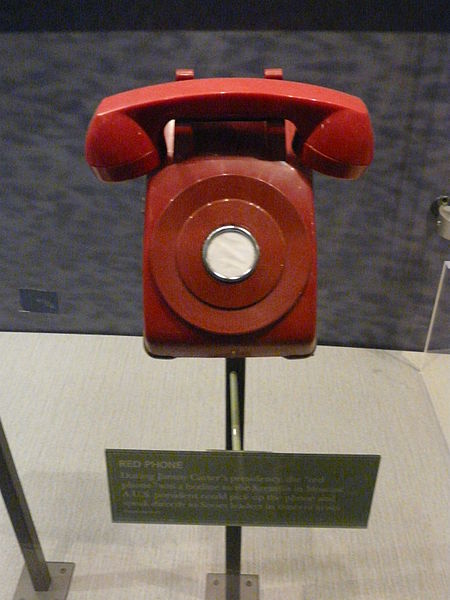Moscow–Washington hotline
The Moscow–Washington hotline is a system that allows direct communication between the leaders of the United States and the Russian Federation. This hotline was established in 1963 and links the Pentagon with the Kremlin. Although in popular culture it is known as the "red telephone", the hotline was never a telephone line, and no red phones were used. The first implementation used Teletype equipment, and shifted to fax machines in 1986. Since 2008, the Moscow–Washington hotline has been a secure computer link over which messages are exchanged by a secure form of email.
ITT Intelex Teletype L015, as displayed in the Lyndon Baines Johnson Library and Museum.
An East German Siemens T63-SU12 teleprinter from the hotline, as displayed in the National Cryptologic Museum of the NSA. The black box behind the teleprinter is an ETCRRM II encryption machine.
A non-dial "Red Phone" which is on display in the Jimmy Carter Library and Museum. This telephone is actually a prop, erroneously representing the hotline between Washington and Moscow.
This "Red Phone" was installed in the CINCSAC underground command post at Offutt AFB. Although connected to a hotline for nuclear warfare command communications, it was a component of the SAC Primary Alert System. It did not connect to foreign officials.
A hotline is a point-to-point communications link in which a call is automatically directed to the preselected destination without any additional action by the user when the end instrument goes off-hook. An example would be a phone that automatically connects to emergency services on picking up the receiver. Therefore, dedicated hotline phones do not need a rotary dial or keypad. A hotline can also be called an automatic signaling, ringdown, or off-hook service.
A typical non-dial red phone used for hotlines. This one is a prop which is on display in the Jimmy Carter Library and Museum, erroneously representing the Moscow–Washington hotline.




